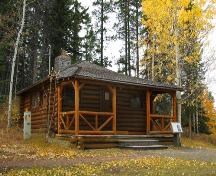KANANAKSIS COUNTRY – If you venture to the northernmost part of Kananaskis Country, south of Seebe and near Barrier Lake, you will come across the Colonel’s Cabin.
This small cabin, constructed of local lodgepole pines, has an interesting history that includes its role in a Second World War POW camp and The Great Depression.
In 1934, the National Forestry Program was established by the Canadian government. This program was under the guidance of the Department of Defense, and its goal was to provide work for unemployed single men during The Great Depression.
As part of this initiative, the Kananaskis Forest Experimental Station was founded and in 1936, what is now called the Colonel’s Cabin was built. The men employed at this station conducted research on tree growth, soils, forest pests, disease, and forest fires. A make-work project for its time, the station turned out to be highly beneficial as it yielded insights into forestry practices and influenced future forestry policies in Alberta and western Canada.
The structure’s role in forestry would be suspended when Canada entered the Second World War in 1939. At that point, the Kananaskis Internment Camp No. 130 was established. The cabin was no longer a forestry station but was now the living quarters for the camp commandant, Colonel Hugh de Norman Watson.
This internment camp was created to house civilian internees and enemy merchant seamen, at least at first. Around the camp were eight main guard towers, equipped with searchlights and guards were sometimes fully armed. There were also two auxiliary towers and a low-voltage warning wire and two high barbed wire fences surrounded the camp. Those first internees slept in military tents until permanent barracks were built.
In 1942, the internees were shipped to facilities in Eastern Canada and the site was enlarged and fortified. At this point, it became a prisoner of war camp. Alberta housed 26,000 prisoners of war during the Second World War, more than any other province, and some of those found their way to the confines of Kananaskis Country.
In all, 650 prisoners of war were housed at the Kananaskis Camp, mostly guarded by veterans of the First World War. Most of the internees had come from the German Afrika Korps, who were captured by the British Eighth Army, American and Free French forces in North Africa.
One man housed at the facility was Manferd Dahl, a 28-year-old man from Claresholm who described himself as a Christian martyr. He was sentenced to nine months at the camp for failing to report for alternative service in the army.
“I stand before this court as a Christian and as hundreds of other Christian martyrs, my conscience is clear,” Dahl said upon hearing his sentence, according to an article in the Calgary Herald.
The internees in the camp engaged in numerous activities during their time there, including clearing the valley that now forms the bed of Barrier Lake. It is said that unlike other prisoner of war camps, no one ever escaped from Camp 130. That may not be the case, as two men were reported to have escaped in December 1939 and were arrested in Calgary.
“When parties of prisoners do forestry work on the surrounding slopes, a blanket guard is thrown around the whole area until the prisoners are back in the compound,” said an article in the Montreal Gazette on March 12, 1940. “Each working party is accompanied by several guards and each prisoner is searched leaving and entering the compound.”
Likely a major reason for this was that internees were treated well, and the location was quite remote for the time. The camp also included a billiards room, tennis courts and in the winter, the prisoners often went on skiing trips.
After the war ended in 1945, the internees were shipped home, and the camp officially closed in 1946.
Today, the Colonel’s Cabin is one of the few buildings in Alberta still standing that has an association with the internment of Second World War prisoners of war. As a result, it was recognized as a Provincial Historic Resource on June 11, 1982.
In more recent years, the camp has served as a forestry office and visitor’s centre in the area.




